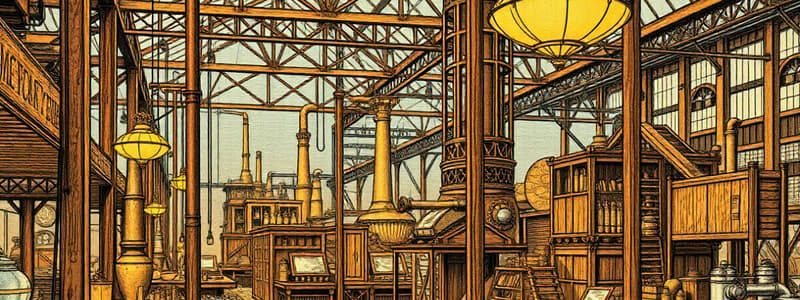Podcast
Questions and Answers
What is manufacturing?
What is manufacturing?
The economic term for making goods and services available to satisfy human wants.
What are goods?
What are goods?
Material things that we buy to satisfy our wants, needs or desires.
What are services?
What are services?
Nonmaterial things that we buy to satisfy our wants, needs or desires.
Which of these is an example of a primary industry?
Which of these is an example of a primary industry?
Which of the following is classified as a tertiary industry?
Which of the following is classified as a tertiary industry?
What is an intermittent production system?
What is an intermittent production system?
What is mass production?
What is mass production?
What elements are included in mass customization?
What elements are included in mass customization?
Which factor is NOT considered in manufacturing?
Which factor is NOT considered in manufacturing?
What does NM-B stand for?
What does NM-B stand for?
What type of insulation is THHN?
What type of insulation is THHN?
What is a service drop cable?
What is a service drop cable?
What does RG-6 refer to?
What does RG-6 refer to?
Wire is made of multiple electrical conductors.
Wire is made of multiple electrical conductors.
Study Notes
Manufacturing and Goods
- The term "Manufacturing" means making goods and services available to satisfy human needs and wants.
- Goods are material items purchased to fulfill wants, needs, or desires.
- Services are intangible items bought to satisfy needs or desires.
Industry Classification
- Primary industries cultivate and exploit natural resources.
- Examples of primary industries are agriculture and mining.
- Secondary industries convert the output of primary industries into products.
- Examples of secondary industries include manufacturing, power generation, and construction.
- Tertiary industries comprise the service sector.
- Examples of tertiary industries are banking, education, government, legal services, retail trade, and transportation.
Production Systems
- Intermittent Production involves starting and stopping production for custom-made products.
- Mass Production involves a specific intermittent production process using standardized methods and single-use machines.
- Mass Customization involves designing, producing, and delivering customized products at a cost similar to mass production.
Elements of Mass Customization
- Modular product design
- Modular process design
- Agile supply networks
Manufacturing - Specifics
- Manufacturing refers to the use of physical and chemical processes to alter the geometry, properties, and appearance of raw materials to create components or finished products.
- Key factors in manufacturing include product design, material selection, manufacturing process, and cost analysis.
Strategies to Reduce Manufacturing Costs
- Lean manufacturing
- Systems approach
Manufacturing Roles
- Manufacturing engineers select and coordinate specific processes and equipment.
- Industrial (Manufacturing) engineers focus on manufacturing systems layout, time study, and cost.
- Materials engineers specify ideal materials and develop new and advanced materials.
Wire and Cable Types
- Wire is a single electrical conductor.
- Cable is a bundle of multiple wires with a common sheathing.
- 14-2G cable contains two insulated wires and a ground wire, with individual wire gauge being 14.
- 14-3G cable contains three insulated wires and a ground wire, each wire being 14-gauge.
- 12-2 w/G has two insulated wires and a ground wire, each wire being 12-gauge.
- 12-3 w/G has three insulated wires with a ground wire, each wire being 12-gauge.
- 600V cable is rated for a maximum of 600 volts and commonly used for residential wiring.
- TYPE NM-B is a non-metallic sheathed cable, commonly used for wiring appliances and devices in homes.
Wire Insulation Labels
- THHN, THWN, THW, and XHHN are common labels found on wires.
- T: Thermoplastic insulation (fire-resistant)
- H: Heat-resistant (up to 167 F)
- HH: Highly heat-resistant (up to 194 F)
- W: Water resistant (for damp/wet locations, also suitable for dry)
- X: Flame-retardant insulation
- N: Nylon-coated (resistance to oil and gasoline)
Service Drop Cable
- Service Drop Cable connects the utility pole to a building.
Communication Cable
- Cables and wires used for signal transmission are called communication cables.
Coaxial Cable
- Coaxial cable is a type of electrical cable with four layers forming a coaxial shape.
- Hardline coaxial (Heliax) is a thick cable with a copper center conductor and a copper or silver tubing shield.
- Radiating coaxial cables have a shield intentionally designed to radiate RF waves.
- RG-6 is the most common coaxial cable used for signal transmission in residential and commercial applications. It has a solid copper wire with a plastic outer layer.
- Triaxial is a coaxial cable with an added layer of insulation and shield over the existing ones.
Insulation Removal
- The preferred method of removing insulation is with a wire-stripping tool.
- A hand wire stripper is used for removing wire insulation, following a specific procedure.
- A knife can also be used for stripping wire, but caution should be exercised.
Hand Wire Stripper Procedure
- Insert the wire into the appropriate wire stripper opening.
- Tighten the stripper and rotate it to cut through the insulation.
- Slide the insulation off the wire.
Knife Stripping
- Use a sharp knife to make a small cut across the insulation.
- Carefully peel the insulation off the wire, taking care not to damage the wire.
- Use a wire stripper if possible, as it is more efficient and less likely to damage the wire.
Studying That Suits You
Use AI to generate personalized quizzes and flashcards to suit your learning preferences.
Related Documents
Description
Explore the fundamental concepts of manufacturing and the classification of different industries. This quiz will cover primary, secondary, and tertiary industries, along with various production systems such as intermittent and mass production. Test your knowledge on how goods and services are produced and distributed.




